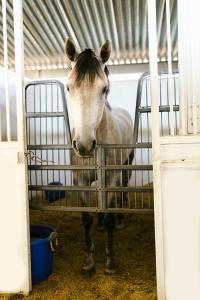10 Things You Might Not Know About Sport Horse Medicine and Rehabilitation
Equine sports medicine and rehabilitation is a comparatively new veterinary specialty. Sarah le Jeune, DVM, DACVS, DECVS, DACVSMR, certified equine acupuncturist, and Jessica Morgan, DVM, PhD, DACVSMR, both specialty clinicians at the UC Davis veterinary hospital, provided some insights into this topic.
1. The American College of Veterinary Sports Medicine and Rehabilitation (ACVSMR) is one of the newest specialty colleges, with sports medicine and rehabilitation becoming a fully recognized veterinary specialty in 2018. “Rehabilitation” in horses is the equivalent of physical therapy in people. Just as human athletes can receive treatment and care from highly trained specialists, the ACVSMR now provides certified specialists for horses and other animals. Diplomates of the ACVSMR complete extensive specialized training in veterinary sports medicine and rehabilitation to improve an animal’s quality of life and athletic performance. An important goal of the college is to generate science-based research studies to expand knowledge and improve protocols for equine rehabilitation.
2. Rehabilitation approaches developed for use in humans are not always effective in horses. Physical therapy in human medicine has been successful partly because the science behind the healing processes, including healing rates for various structures, is well understood. There is currently a lack of randomized clinical trials with large numbers of horses to describe evidence for the effectiveness of different approaches. More science and clinical-based information is needed to inform effective protocol development for equine rehabilitation.

3. A rehabilitation program is only as good as its underlying diagnosis. Clinical signs generally drive the initial treatment plan. Functional assessments and global measures related to pain, proprioception, range of motion, strength, motor control, endurance, and neuromuscular function contribute to the overall diagnosis. Clear identification of the issue(s) leads to the most effective rehabilitation plans and successful outcomes.
4. Rehabilitation is a process; plans and schedules often need constant readjustments. Appropriate rehabilitation programs seek to provide the best possible treatment to each individual horse during different stages of healing. It is important to consult a trained specialist (see #1) to ensure the safest and most effective outcomes for individual situations. Successful rehabilitation programs involve teamwork and collaboration from owners, veterinarians, farriers, nutritionists and others involved in equine care. No one-size-fits-all approach meets all patient needs.

5. Equine rehabilitation historically involved prolonged periods of rest (i.e. stall rest), but research has shown that immobilization can have detrimental effects on muscle function, joint flexibility, cartilage degeneration, and the formation of scar tissue in some cases. New approaches provide alternatives that can keep horses moving while still allowing injuries to heal. Controlled exercise programs tailored to the diagnosis are important components of rehabilitation. This is especially important for horses that have other injuries or conditions, such as osteoarthritis, that may worsen during periods of confinement.
6. Dietary issues are drivers of decreased performance. It is important to evaluate weight and body condition score, especially after an injury or illness. As a horse’s weight and activity level change during the rehabilitation process, nutritional assessments may be recommended. Rehabilitation approaches can also be employed to manage issues such as obesity by providing targeted exercises that increase muscle and fitness under controlled conditions to limit the risk of injury.
7. Rehabilitation programs are not just for sport horses. Maintaining appropriate levels of physical fitness is important for all horses, especially as they age. Rehabilitation programs can be tailored to horses of any age or activity level to maintain function, facilitate performance, and ensure optimal quality of life over time. Preventative approaches to equine health can lead to early diagnoses and successful targeted treatments.

8. Horses hold their breath when swimming. Horses experience periods of apnea (breath-holding) in which they flatten their nostrils during swimming exercise. This is thought to aid buoyancy and may be a manifestation of the mammalian dive reflex (MDR). All air-breathing vertebrates possess the MDR, which slows the heart rate and redirects blood to the heart and brain to conserve oxygen during extended submersion. This should be taken into consideration when evaluating hydrotherapies to avoid exacerbating any existing respiratory conditions.
9. Boots and leg wraps are used to protect the lower limbs during exercise, but research indicates that they cause increased surface temperatures that may be detrimental to underlying tendons. A study that evaluated neoprene boots, cross-country boots, and polo wraps, with bare legs as controls, found higher temperatures in all booted/wrapped legs compared to the bare leg. The highest humidity was 94% under the polo wrap. The researchers concluded that boots and wraps may impair evaporative cooling of the legs (Brock and Spooner, 2022).

10. Riders and tack are part of the rehabilitation equation. Rider asymmetries and poorly fitting tack can exacerbate existing conditions and influence the risk of reinjury. Saddle fit, in particular, should be evaluated throughout the rehabilitation process as the horse’s shape can change significantly with alterations to workload and body condition. It is good practice to address these factors on a regular basis, ideally several times over the course of a year as the recovering horse gets stronger and develops more muscle.
